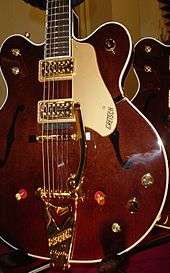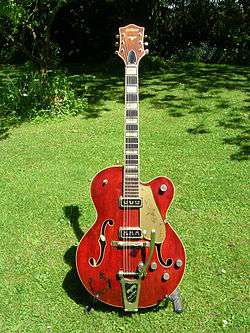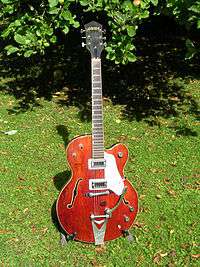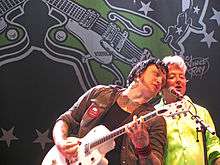Gretsch
 | |
| Private | |
| Industry | Musical instruments |
| Founded | 1883, Brooklyn, New York City, New York |
| Headquarters | Savannah, Georgia, United States |
Key people |
Friedrich Gretsch Fred Gretsch, Sr. Fred Gretsch, Jr. William Walter "Bill" Gretsch Fred W. Gretsch Dinah Gretsch |
| Products |
Drum kits Banjos Mandolins Ukuleles Guitars Bass Guitars Lap steel guitars Guitar amplifiers |
| Divisions |
Gretsch Drums Gretsch Guitars Bigsby Vibratos Leedy Drums |
| Website | gretsch.com |
Gretsch is an American company that manufactures guitars, basses and drums. The company was founded in 1883 in Brooklyn, New York by Friedrich Gretsch, a 27-year-old German immigrant, shortly after his arrival to the United States. Friedrich Gretsch manufactured banjos, tambourines, and drums until his death in 1895. In 1916, his son, Fred Gretsch Sr. moved operations to a larger facility where Gretsch went on to become one of the most prominent manufacturers of American musical instruments.
Most modern-era Gretsch guitars are manufactured in the Far East, though American-made "Custom Shop" models are available. In 2002, Gretsch entered a business agreement with Fender Musical Instruments Corporation (FMIC). Under the terms of that agreement Fred W. Gretsch would retain ownership while FMIC would handle most of the development, distribution and sales.[1]
History
Beginnings

Gretsch was founded in 1883 by Friedrich Gretsch, a young German immigrant who opened his own musical instrument shop on 128 Middleton Street in Brooklyn, New York in 1883.[2]. His shop was designed for the manufacture of banjos, tambourines, and drums.[3] The operation moved to South 4th Street in 1894. In 1895, Gretsch died at the age of 39, and company was taken over by his wife and fifteen year-old son Fred.
Fred Gretsch expanded the business, adding Gretsch Building #1 at 109 South 5th Street in 1903, Gretsch Building #2 at 104-114 South 4th Street in 1910, and a new ten-story Gretsch Building #4 at 60 Broadway in 1916.[4] The company ultimately owned or operated six properties in the immediate area, including a warehouse on Dunham Place. Gretsch Building #4 was owned by the Gretsch family until 1999. Guitar production by the Gretsch Company began in the early 1930s, and Gretsch guitars became highly sought after, most notably in the 1950s and 1960s.
1950s, 1960s, 1970s

Fred Gretsch Sr. handed over the family business to his son, Fred Gretsch Jr., after retiring in 1942. Soon after taking over, Fred Jr. left to serve in WWII as a Navy commander, leaving the business in the hands of his younger brother, William Walter "Bill" Gretsch. Bill Gretsch died in 1948 and the company was again run by Fred Jr.
By the mid-1950s the company introduced several models, including the 6120 "Nashville," and the Duo Jet chambered "solid body", which was played by Bo Diddley.[5] Two other models were introduced - the Country Club, and the White Falcon.
During this time, Chet Atkins became an endorser of Gretsch and they sold guitars with Atkins' name on the pickguard,[6] most notably the 6120 Chet Atkins model, one of which was purchased in 1957 by a young Duane Eddy. The worldwide success of Eddy's "twangy" instrumental records, television appearances, and extensive touring helped expose the Gretsch guitar to the teenage rock-and-roll market. George Harrison, years later, would refer to this model as "the Eddie Cochran/Duane Eddy guitar." Other "Chet Atkins" models were the Country Gentleman (named after an Atkins instrumental hit) and the Tennessean, a lower-cost version of the Country Gentleman.

Many rockabilly players had followed in the footsteps of Eddie Cochran, who also played a 6120 (though modified with a Gibson P-90 pickup in the neck position) and Gene Vincent's guitarist Cliff Gallup, who played a Duo Jet.
Elvis Presley later owned a Gretsch Country Gentleman — (recently manufactured as the "Gretsch Country Classic" but renamed the Chet Atkins Country Gentleman) — playing it briefly both on stage and in the studio.
Gretsch quickly became a legitimate competitor to both Gibson and its main rivals, Fender and Rickenbacker.
Gretsch fortunes rose again in the early Sixties when George Harrison played a Gretsch Country Gentleman[7] on The Ed Sullivan Show. He would later switch to a Gretsch Tennessean and his Country Gentleman made its last appearance in the music video of "You're Going to Lose That Girl" in the movie Help! That guitar was later given to Ringo Starr by Harrison's wife, Olivia.[8]
The British Invasion brought further popularity to Gretsch models. In addition to the Beatles, Brian O'Hara of The Fourmost used a Country Gentleman.
- John Lennon at one point acquired a Nashville (double-cutaway).
- Eric Clapton used a double-cutaway 6120 during his early days with The Yardbirds.
- The Animals' Hilton Valentine played a Tennessean on the classic "House of the Rising Sun".
- Brian Jones of The Rolling Stones used a 1963 model 6118 Double Anniversary from late 1963 to mid-1964. It was used on their version of "I Wanna Be Your Man" as well as the Rolling Stones' first album, a few tracks on 12 x 5. It was also used on the Rolling Stones first American Tour in June 1964.
- Gerry Marsden, of Gerry and the Pacemakers, can also be seen using a Gretsch guitar.
- Steve Marriott of the Small Faces played a Tennessean, a Duo Jet and a White Falcon during his time in that group.
- Beginning in 1966, Gretsch had weekly television exposure when the company supplied the guitars and drums for The Monkees, increasing the demand for its guitars.
- Both Lou Reed and Sterling Morrison of the Velvet Underground used a Gretsch Country Gentleman during the band's lifetime (although not simultaneously; they shared the same guitar), as did The Stone Roses guitarist John Squire.
- In the 1960s, Gretschs were seen in the hands of Stephen Stills and Neil Young,[9] who both played White Falcon models on the Buffalo Springfield's lone hit, "For What It's Worth".
- Pete Townshend of the Who also used a '59 orange Gretsch 6120 (given to him by Joe Walsh) on their 1971 Who's Next and 1973 Quadrophenia albums, including their hits, "Bargain", "Won't Get Fooled Again" and "5:15".
- Paul Atkinson of The Zombies played a Gretsch 6120 in his tenure with the band, while also using a Rickenbacker.
During the 1950s and 1960s, Gretsch also sold several different models of amplifiers badged with the Gretsch name to accompany its guitars. These were actually manufactured by Valco, and have become sought-after in the years following Valco's demise.
Both guitars and drums were manufactured at 60 Broadway until the mid-1960s, at which time drum production was consolidated at 109 South 5th Street so that guitar production could be expanded.
Sale to Baldwin, Gretsch family regains interest
Fred Gretsch never found a suitable successor, and in 1967 Gretsch was sold to Baldwin Pianos,[10] becoming a subsidiary of that firm. Mid-1969, Baldwin moved Gretsch instrument manufacturing operations from Brooklyn to a plant in DeQueen, Arkansas.[11]
During the "Baldwin era", new models were introduced throughout the 1970s and old favorites continued to be produced. As solidbody guitars rose to prominence in rock, with the harder styles of the era favoring Fender Stratocasters and Gibson Les Pauls, use of hollowbodies fell in popularity. In 1979, after Fred Jr's death, Chet Atkins withdrew his endorsement in response to quality problems and Gretsch's unwillingness to pursue his vision of a nylon-stringed electric guitar. Factory fires in the early 1970s caused serious problems, and production was finally halted by Baldwin in 1981.
In 1985, Gretsch was bought back by Fred W. Gretsch, nephew of Fred Gretsch Jr. and son of the late William "Bill" Gretsch. At that time, drum production was relocated to Ridgeland, South Carolina, where it remains today. The first new guitar model introduced was the Traveling Wilburys model - an Asian import - which looked much like a Danelectro. While this guitar model did little to bolster Gretsch's reputation for producing classic guitars, it served notice that Gretsch was back.
After numerous failed attempts to acquire facilities or contract production in the United States, Fred Gretsch and long-time Gretsch employee Duke Kramer, who advised Gretsch, turned to Terada of Japan, and production began there. A range of reissues appeared throughout the 1990s to mixed reviews. They were of generally high quality, but with notable non-vintage details and features. Occasional U.S.-built "Custom Shop" models were offered at significantly higher prices.
Resurgence

In the 1980s, rockabilly revival player Brian Setzer rekindled interest in the brand with his band The Stray Cats. His influence continued through the 1990s with The Brian Setzer Orchestra. In 1990, Setzer became the first player since Chet Atkins to be honored with a signature-model Gretsch, the "Brian Setzer 6120", first of a line of Setzer signature models.
The cover art of George Harrison's eleventh studio album, Cloud Nine (1987), features Harrison's first American-made guitar, a 1957 Gretsch 6128 Duo-Jet that he purchased in Liverpool in 1961. Harrison called it his "old black Gretsch". Gretsch released the G6128T-GH George Harrison Signature Duo Jet guitar, modeled on the instrument Harrison's "first real decent guitar." Gretsch also made a run of 60 limited-edition replica G6128T-GH George Harrison Tribute Custom Shop Duo Jet guitars, exact down to reproducing the original's scuffs and scratches; Harrison's son Dhani remarked, "I've never seen a more precise and detailed replica of any guitar in my life."
Autralia'a own guitar legend Chris Cheney of The Living End also has a signature White Falcon produced and named in his honour, bringing the Gretsch name and sound to an entire new generation. With an international music career over 27 years, with 7 albums and a string of superband appearances including The Beatle's White Album, David Bowie Tribute and Easyfever, this aussie legend has notched up a legion of players lining up to get their own Gretsch.
Gretsch guitars achieved some popularity among New Wave and alternative rock guitarists in the 1980s. Johnny Marr, Martin Gore, and Matthew Ashman played Gretsch guitars.[12][13][14]Roddy Frame plays two different Gretsch models in music videos for Aztec Camera's Love and Stray albums: "Somewhere in My Heart"[15] and "The Crying Scene".[16] Billy Duffy of The Cult played a White Falcon and has a signature model.[17] John Squire of The Stone Roses played a Country Gentleman on many recordings and live performances.[18] William Reid of Jesus and Mary Chain played a Tennessean,[19] as did Robert Smith of The Cure.[20]
Jim Heath (stage name Reverend Horton Heat) also has a signature model.[21] While Gretsch never issued a signature model for Poison Ivy Rorschach of the band The Cramps, she frequently used a 1958 Chet Atkins 6120 since 1985.[22] Heath was influenced by Ivy's guitar playing.[23]
FMIC control
In late 2002, Gretsch and the Fender Musical Instruments Corporation reached an agreement giving Fender most of the control over marketing, production, and distribution of guitars, with the Gretsch family retaining ownership of the company.[24]
Fender instituted a program intended to restore production practices of the era of Gretsch's greatest popularity. Body and headstock shapes were made more "vintage correct." Hollowbodies resumed construction from three-ply wood laminate rather than the five-ply of the 1990–2002 period. Duo Jets were chambered in accordance with vintage practice. The trestle bracing of the 1959–1961 era was re-introduced on the Setzer line and other selected models.
Gretsch also introduced models with features intended to attract modern players, including TV Jones pickups, locking Sperzel tuners, and "ML" bracing designed by Mike Lewis of FMIC and Masao Terada of the Terada company in Japan, where all Gretsch Pro Series guitars are built.
FMIC discontinued the low-end bolt-neck Electromatic models of the late 1990s and early 2000s. The renewed Electromatic Hollowbody line became successful, from the 5125–5129 series (with U.S.-made DeArmond 2000 pickups) and the similar 5120 series. The 5120, a single-cutaway model inspired by the 6120, became the best-selling guitar in Gretsch history. The double-cutaway 5122 model, introduced in 2008 and inspired by the 6122 Country Gentleman, filled out the Korean-built Electromatic Hollow line.
The Electromatic line also included Pro Jet and Double Jet chambered solidbodies based on Gretsch's Duo Jet line, equipped with Gretsch mini-humbuckers unavailable on any other model. The Electromatic line included the Corvette series, thin mahogany solidbodies based on the Corvette model of the early 1960s, but with the newly designed Mega'Tron double-coil pickups exclusive to the Corvette line.
For a time, Fender also issued the first Gretsch-badged amplifier since the days of Valco. The Gretsch G5222 Electromatic amp was a five-watt tube combo with six-inch speaker, essentially a redressed Fender Champion 600 reissue with differing upholstery and grill material. Though the Champion 600 was discontinued in 2010, the G5222 remained available for a few more years.
Yet more signature models and endorsements
In January 2007, with the agreement of the Atkins family, Gretsch announced the return of Chet Atkins as an endorser, despite being dead since 2001. The Country Classic models became Country Gentleman again, the 6120 Nashville resumed being the Chet Atkins Hollowbody, and the Tennessee Rose became the Chet Atkins Tennessee Rose. In July 2008, a limited run of Chet Atkins 6120 Stereo guitars was introduced, based upon a 1956 prototype featured in several landmark Atkins recordings but never produced in quantity.
Billy Zoom of the Los Angeles punk band X was honored with a limited-edition Gretsch Custom Shop Jet model in 2008 based on Zoom's vintage Jet, and includes more extensive internal chambering than any modern Jet, exactly reproducing the construction revealed when Zoom's original guitar was CAT-scanned during development.
Billie Joe Armstrong of American punk rock band Green Day used FMIC-era Gretsch Guitars on the albums ¡Uno!, ¡Dos!, and ¡Tré!. Lady Gaga plays a Gretsch in the music video for "Million Reasons." Both Patrick Stump of Fall Out Boy and G. Love have been honored with signature-series Electromatic Corvettes, the G. Love introduced in January 2008 and Stump's "Stump-o-matic" in January 2009.
Drums
During the 1950s and 1960s, many renowned Jazz drummers, such as Elvin Jones, Tony Williams, Art Blakey, Philly Joe Jones, Max Roach, and even Billy Cobham (during the early 1970s in the early Mahavishnu Orchestra days) utilized Gretsch drums. They were all playing the now classic "round badge" kits.
- Micky Dolenz also used Gretsch drums during the filming of the Monkees TV series.
- Phil Collins used a Gretsch drum kit for many years while touring with Genesis, also legendary studio and all around drummer Vinnie Colaiuta played Gretsch.
- Charlie Watts of the Rolling Stones has played Gretsch drums for forty-five years.
- Other artists who have used Gretsch drums include Brad Wilk from Audioslave and Rage Against the Machine, Taylor Hawkins of Foo Fighters, Debbi Peterson of The Bangles and Steve Ferrone of Tom Petty and the Heartbreakers
- Green Day's Tré Cool began using Gretsch drums during the recording of the band's ¡Uno!, ¡Dos!, and ¡Tré! albums.[25]
Replicas
Harmonix Music Systems released a replica Gretsch Duo-Jet Guitar controller alongside the release of The Beatles: Rock Band.
References
- ↑ Guitars of the Fred Gretsch Company - Jay Scott
- ↑ "Brooklyn Walking Tour: Traveling Through Gretsch History Today" by Fred Gretsch. Gretsch.com/
- ↑ "Gretsch History: Best performances start with Gretsch guitars & drums, on stage since 1883. A music-industry leader since 1883. Learn about our many music industry firsts!". Gretsch.com. Retrieved 2012-12-20.
- ↑ “These Luxury Lofts Are Home to Rock History and a Rocket-Related Mystery” by Natalie Lampert Bedford + Bowery, December 30, 2014.
- ↑ Hilmar, Jim (2013-12-31). "Gretsch Jet Firebird". Vintage Guitar magazine. Retrieved 2018-02-23.
- ↑ "Gretsch 6120 models: Gretsch-GEAR: The Gretsch Pages". gretschpages.com. Retrieved 2018-02-23.
- ↑ "Image: nicegent2.jpg, (399 × 475 px)". thecanteen.com. Retrieved 2015-09-28.
- ↑ John Crowley. "Mark Hudson Interview". thecanteen.com. Retrieved 2015-09-28.
- ↑ "From Bo Diddley to The Beatles to U2, Gretsch Guitars Have Been a Key Part of Rock and Roll's Explosion". Guitar World. Retrieved 2018-02-23.
- ↑ Gjörde, Per (2001). Pearls and Crazy Diamonds. Göteborg, Sweden: Addit Information AB. pp. 35–37.
- ↑ "Brooklyn Walking Tour: Traveling Through Gretsch History Today" by Fred Gretsch. Gretsch.com/
- ↑ "Johnny Marr". Retrieved 2016-03-10.
- ↑ "Depeche Mode's Martin Gore". web.archive.org. Retrieved 2016-03-10.
- ↑ "Matthew Ashman". Retrieved 2016-03-10.
- ↑ "Aztec Camera - Somewhere In My Heart" (Video upload). Yelens82 on YouTube. Google Inc. 15 October 2010. Retrieved 2014-04-18.
- ↑ "Aztec Camera - Crying Scene [OFFICIAL MUSIC VIDEO]" (Video upload). RhinoEntertainment on YouTube. Google Inc. 13 September 2013. Retrieved 2014-04-18.
- ↑ "Billy Duffy Falcon". web.archive.org. Retrieved 2016-03-10.
- ↑ "Gretsch Electric Guitar Stars". Retrieved 2016-03-10.
- ↑ Howe (2014), 75
- ↑ Bacon (2005), 89
- ↑ "G6120RHH Reverend Horton Heat by Gretsch® Electric Guitars". Archived from the original on 2010-11-14. Retrieved 2015-09-28.
- ↑ "Poison Ivy |". vintageguitar.com. Retrieved 2015-09-28.
- ↑ "Reverend Horton Heat - ThePunkSite.com". thepunksite.com. Retrieved 2015-09-28.
- ↑ Tim Baxter/APTgroup. "Gretsch History". The Gretsch Pages. Retrieved 2012-12-20.
- ↑ "Gretsch Drums". Retrieved 2012-11-20.
Bibliography
- Bacon, T. (2005). (Ed.). 50 Years of Gretsch Electrics. Backbeat Books. San Francisco. ISBN 0-87930-822-2.
- Bacon, T. (2000). (Ed.). Fuzz & Feedback: Classic Guitar Music of the 60's. Miller Freeman Books. San Francisco. ISBN 0-87930-612-2.
- Howe, Z. (2014). (Ed.). Barbed Wire Kisses: The Jesus and Mary Chain Story. Polygon. Edinburgh. ISBN 978-1-84697-331-4.